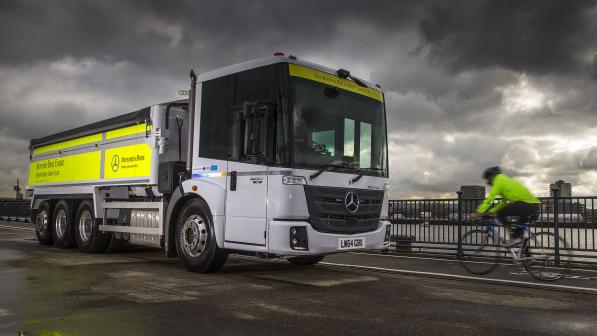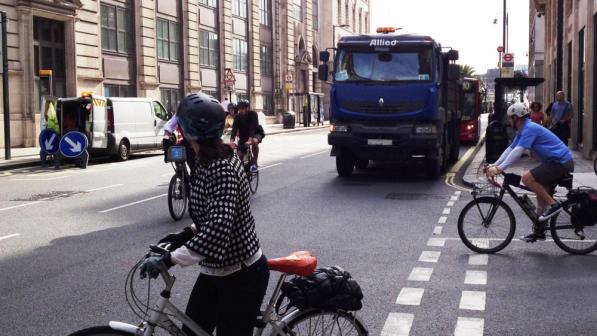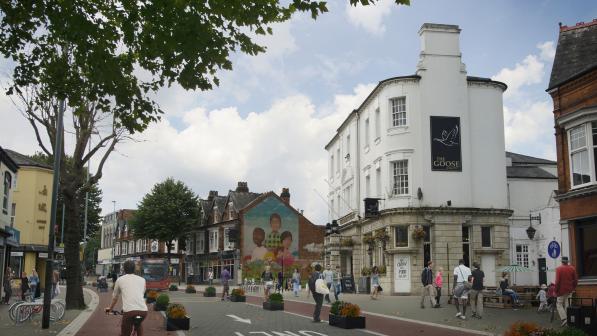Exchanging places

Working for Avanti Cycling, one of the cycle training providers in the south of England, I have been helping to deliver the Safe Urban Driving course to lorry and heavy goods vehicles (HGV) drivers for about a year. It has been a delightful experience, a lot of fun and very rewarding to see drivers appreciate how changing their behaviour can greatly improve cyclists’ experience and safety.
Professional drivers have to complete 35 hours of training over five years for their Driver Certificate of Professional Competence to keep their licence. Safe Urban Driving is a seven-hour course, with half a day in the classroom learning about vulnerable road users and how the roads (particularly in London) are changing to accommodate cycling.
The fun part of the day is the other half, out on bikes. Starting with half an hour in the car park, the drivers are given time to get familiar with their bikes. This means remembering things regular cyclists take for granted, such as how to signal, stop, change gear and general bike handling so that they are a bit more confident before going out on the road.
They say you never forget how ride a bike but, for many drivers, it has been a long time since they last rode: 50 years in one case. In another, the driver had never ridden a push bike before, though was a regular motorbiker!
As part of the training, we look at why cyclists ride away from the kerb; how to help drivers see you on the road; avoiding gullies, grates and pot-holes; positioning at junctions – in the centre of the lane so that they can be seen better; and keeping out of the ‘door zone’, well away from opening car doors.
Following training on the Safe Urban Driving course, these professional drivers should be able to recognise these dangers, and avoid forcing cyclists into potential hazards.
It's always a good end to the day when I hear some say they will get the bike out and enjoy the occasional ride, or even start riding to work!
Glenn Blake, Cycling UK volunteer and cycle training provider
The road infrastructure for cyclists is another challenge. “Why don’t cyclists use the cycle paths provided?” is a common question, soon answered when they are on their bikes. It’s only then that the drivers realise why not all cyclists do so, namely safety.
It swiftly becomes clear that feeder lanes for advanced stop lines at traffic lights are leading cyclists along the left-hand side of a large vehicle to stop in front of it. This is exactly where the blind spot is on an HGV – and those lines of white paint marking cycle lanes don’t offer much protection!
The aim is to ride for about five miles, sometimes a bit more. The trick is not to mention the distance before we start, as most would simply refuse! Having said that, it’s very rare that anyone fails to get round.
From the drivers’ perspective, their big gripe is cyclists not being visible, with dark clothing and no lights frequently mentioned. Cyclists riding two abreast is another bugbear, but after a little explanation they seem to understand that riding in single file doubles the length of time needed for overtaking.
They say you never forget how ride a bike but, for many HGV drivers, it has been a long time since they last rode: 50 years in one case!
Glenn Blake, Cycling UK volunteer and cycle training provider
Responsible haulage companies will have fitted the latest mirrors to their fleets to give drivers a better view. Additional sensors and CCTV will also help, but cyclists are well advised to take care around large vehicles as, sat up in the cab, even with all those mirrors and sensors, drivers may still only have a limited view.
Unless you’re a lorry driver, another element you might not pick up on is the slow acceleration. Most modern lorries will have ‘eco-drive’, which makes acceleration very slow and overtaking difficult, even a bike.
As part of the training, we look to generate useful discussion, which helps us to address some of the common questions about cycling. Topics raised at the frequent stops include active travel initiatives, the health benefits and the way congestion and pollution can be reduced with more cycling. Less sensible topics such as ‘road tax’ and cycle insurance usually come up too.
Ultimately, the drivers on this course learn a greater appreciation of what cyclists face on the roads and an understanding of why cyclists do some of the things they do. However, it’s not all just work, as we do try to include a bit of ‘fun time’ as a reminder of what a pleasure cycling can be.
It’s always a good end to the day when I hear someone say they will get the bike out and enjoy the occasional ride, or even start riding to work!



